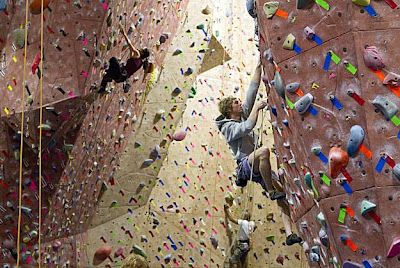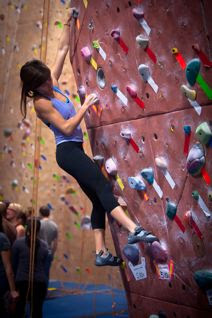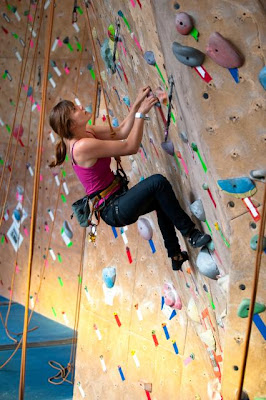Check us out! Your favorite San Francisco climbing best was featured in the Health & Fitness Section of the San Franciso Chronicle!
By Chris Holt
Originally Published in the SF Gate.
Like many rock climbers, Christine Ambrose, a project manager at the San Francisco-based Save the Redwoods Foundation, learned the “ropes” later in life. First drawn to climbing through canopy research – the process of collecting scientific data in treetops – Ambrose, 43, was formally introduced to the sport when a friend took her climbing in June. It was then, she said, “a passion was born.” On a recent weekday night she was hanging out at Mission Cliffs Climbing & Fitness on 19th and Harrison streets, enjoying the social aspect of the sport. “I’ve met so many nice people climbing,” she said.

Mission Cliffs is one of 9 climbing and fitness gyms managed by Touchstone Climbing in California. The first of its kind in San Francisco, it opened in 1995 but didn’t gain a following until around 2000 when the sport surged in popularity. Today, there are an estimated 10 million climbers in the United States, with a sizable percentage in the Bay Area.
Despite superior climbing features and fitness facilities at some other gyms, Mission Cliffs remains one of the most popular, with a cult following. That’s due only in part to its convenient location in the heart of the Mission. After trying out other gyms, Ambrose settled on Mission Cliffs because of its “down-to-earth quality.” Other members regularly cite the open, welcoming vibe and the “friendly, quirky” staff as reasons for their patronage.

Rows of bicycles hang over the railing at the entrance of Mission Cliffs’ converted
warehouse. The front desk stereo blasts everything from the Clash to Bob Marley, and inside the gym the conversation is almost deafening. While working out in a conventional gym is a mostly solitary activity in a hushed setting, climbing is collaborative and social. “MC is always bustling. During peak hours you can’t even hear the music over the conversation, falling climbers and the nearly constant call for climbing partners,” said Nick Lane-Smith, 30, a local technology entrepreneur and a climber of six years.
Venturing up the 50-foot walls at Mission Cliffs requires a partner. Most people bring one, but the gym encourages members to meet others. Announcements over the loudspeakers regularly call for “top-roping” for unpaired climbers. In top-roping, a rope is anchored to the top of the wall through a pulley system, and attached to the climber and “belay partner” on the ground. The belay partner provides weight at the other end of the rope, acting as a brake that keeps climbers from hitting the ground in the event they fall.
In “lead climbing,” an advanced technique that allows the climber to “lead” the rope up the wall, there is no top anchor. Climbers, attached to belay partners on the ground, clip into carabiners (heavy metal loops) placed in the wall. Falling while lead climbing can create a spectacle. Not only are the drops longer, but also the belay partners providing the opposing weight are often lifted off the ground by the force of the drop. Climbers become part of the audience, standing around and cheering on others as they reach for a particularly challenging handhold.

On the second floor of Mission Cliffs is the 2,000-square-foot bouldering cave, where people sit around and tell stories, trade advice and problem-solve. Bouldering is done on small walls and doesn’t require ropes or partners. Climbers jump on and off the walls, sometimes focusing on singular climbing moves for hours. “There’s more of a social scene up here,” said a climbing-chalk-covered Michal Kubicki, an attorney who lives in the Lower Haight.
The popularity of the sport isn’t surprising, considering the hiking trails, well-formed rocks, and parks like Joshua Tree, Indian Rock, Castle Rock and Desolation Wilderness within driving distance of the Bay Area. Climbers can practice indoors year-round and plan outdoor trips based on weather and optimal climbing conditions.
While many people train to summit landmarks in the great outdoors, others enjoy indoor climbing as its own sport. It strengthens the core, leg and arm muscles, while improving flexibility. It’s also a complement to yoga, because of its emphasis on focus, flexibility and balance. Whether bouldering or top-roping, there’s problem-solving involved. Rarely is a climb as straightforward as moving up a ladder. Knowing how to shift your weight, where to place your feet, how to reach the next hold is an intensely challenging and cerebral exercise.
The walls at Mission Cliffs may be filled with a fair share of the local 20-40 age group, but Adam Barczak, a staffer at Mission Cliffs, says membership encompasses a wide age range – from toddlers to retirees. Franco Faraganu, 61, an instructor, has been climbing for more than 30 years. There are kids’ birthday parties and regular juvenile climbers as well. One member often brings his 4-year-old niece to climb the walls.

